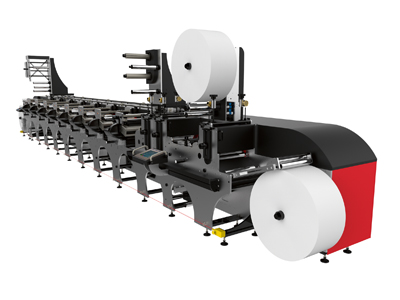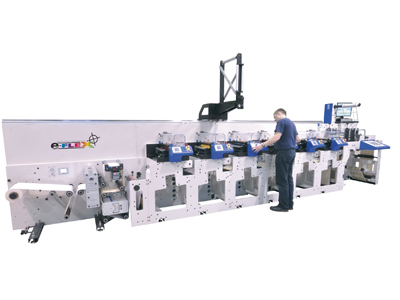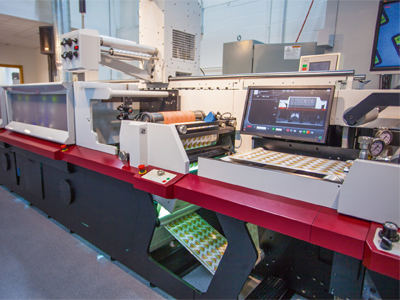Mark Andy’s new hybrid the Digital Series as seen here during an Open House in the US last year
Narrow web flexo printing may be a mature technology, but there are a number of new presses and trends to take note of for this year. By Nessan Cleary.
A quick survey of the label market reveals two, almost contradictory factors. Firstly, narrow web flexo remains the dominant technology for producing labels. Secondly, digital technology is becoming increasingly popular. Consequently just about every flexo press manufacturer is currently in the process of developing a hybrid digital machine though not all of these are yet available in the European market. Some of this is driven by the need to compete against the growing number of inkjet printers, though most of these hybrid presses are limited to the same speed, and cost considerably more than the inkjet brigade.
Nonetheless, Antony Cotton, technical sales manager for Focus Label Machinery, said there is a lot of interest in combining digital printing with a conventional press. He points out that inkjet presses can only handle relatively short run lengths, but that many customers want the flexibility of being able to take on both short run and longer jobs.
He said there is a move towards shorter run lengths, but added, ‘It’s a lot easier to change designs more regularly and you can use variable data and sequential data so there are other factors as well.’ He continued, ‘The demand for digital has been there for a while but is becoming more accessible in terms of quality and speed and there are a number of suppliers now.’
More hybrids
Focus too has developed its own hybrid machine, the d-Flex, which combines a single colour rotary flexo with single pass inkjet printing for four colours plus white. It is designed for short run work. The flexo unit can be used for printing, laminating, foiling and die-cutting so that a complete job can be produced in a single pass. It is a modular system, with a choice of widths from 142 mm and 220 mm through to 330 mm and can run at up to 50 m/min. The inkjet printheads are from Konica Minolta and the resolution is 360 x 720 dpi.
Mark Andy launched its Digital Series hybrid press into the American market at last year’s Labelexpo show in Chicago. The standard press uses CMYK, but it can also be configured with orange and violet, and there is an option for white. This is not yet available to European customers, but UK sales manager, Paul Macdonald, said that it should be shown at the Labelexpo show in Brussels this September.
Mr Macdonald siad that digital technology is becoming more important so that Mark Andy has invested in developing its press. ‘But,’ he added, ‘flexo is still the dominant process and likely to remain so for at least the next five to six years. In areas such as general foods where there are huge runs I can’t see anybody being able to replace flexo economically.’
Gallus, now owned by Heidelberg, has also developed a hybrid digital press, the DCS 340. This uses a Fujifilm inkjet system for 1200 dpi resolution. Stefan Heiniger, chief operating officer, said that digital printing will grow over the next 10 years, noting, ‘Due to continuing growth in short run label production and personalised, versioned labels, we are seeing investment on the market steadily shift towards printing presses that utilise digital printing.’ It is due to be launched commercially at the Labelexpo show later this year.

Edale’s main narrow web flexo offering is this FL3, a highly automated 350 mm wide press
Edale has partnered with a number of other companies to develop digital solutions. Thus FFEI’s Graphium press, which is an inkjet press that can be configured with modular flexo units, is built on an Edale chassis. AB Graphic International has also used an Edale base for its Digicon 3000, which is widely used as a finishing line for digital label and packaging presses.
Omet has also recently showed off its inkjet press, the JetPlus. This is a four colour modular unit developed together with Domino. This was first shown at drupa in 2012, and a beta unit installed at a customer site in 2013 where it was further developed prior to a full commercial launch at the end of last year. For now it can be used inline with the X6 flexo press and Omet is looking at making it available for its other models, such as the Varyflex V2. At around 60 m/min, it is slower than a flexo line. Massimo Bellingardi, marketing coordinator, pointed out, ‘You can use the digital printing with finishing such as cold foil and die-cutting inline.’
Greater automation
Omet’s X6 is a highly automated press and Mr Bellingardi said that this automation makes it easy to work with different materials from paper to film and carton, adding, ‘This means you can do a wider range of products from labels and flexible packaging on the same machine.’
The company recently added an offset option to this press. As it already supports several processes, it is now possible to have offset, rotogravure, silkscreen and digital all on the same flexo-based machine. Omet also recently added a new 440 mm width size to the XFlex X4 entry-level flexo press.
Gidue too is fully committed to automation in the belief that this can speed up the makereadies for a conventional press to allow it to compete with digital presses. Thus it has further developed its Digital Flexo Excellence technology.
The basic concept is that the makeready for the next job should be done while the previous job is still printing to radically minimise the changeover time between jobs. Thus the print cylinders are prepared in the machine and the actual changeover happens on the fly with minimal operator intervention. Gidue claims that it loses less than 10 metres of substrate when changing eight cylinders and that the whole operation takes less than a minute. There is a camera control system that recognises the new job and can automatically adjust the pressure and register systems accordingly. This has now been added to an M5 flexo press.
Gidue is also heavily involved in the Revo initiative in which a number of manufacturers have teamed up to develop an optimised flexo solution. The aim is to create automated plug and play solutions for greater productivity and faster changeovers to enable flexo presses to compete better against digital presses. (See also article on p 45).
However, Nick Tyrer, UK sales director for MPS, said that not all customers necessarily want or need greater automation, noting, ‘Some people prefer to have their press as standard and believe that automation doesn’t offer much, while others want to de-skill the process by using a higher level of automation.’
MPS sells an automation package for around €70-100,000 that allows customers to choose the level of automation, if any, they want. This can include features such as Job Memory, where all the settings for a given job can be automatically chosen, saving time on having to set the press up.
Flexibility is key
Nilpeter is looking to greater automation to affect the crossover point between flexo and digital. Thus at the last Labelexpo America show, it demonstrated its FB-3 and FA-4* presses. Paul Teachout, vice president of sales and marketing in North America, explained, ‘Now with a simple recall of a job, fast change of plate cylinders, with full automation resetting the job, we are back into impression and register with zero waste, and that is highly competitive.’
The Danish manufacturer has also demonstrated printing with extended colour gamuts on an FB-3 UV flexo press, which can recall the operating parameters of previous jobs. Thus, the primary seven colours stay in the press to build spot colours and process graphics, which in turn reduces wash-ups, makeready, and downtime.
MPS has launched the EB press, which is designed as a highly automated machine at a competitive price. This features iStop, which eliminates the normal substrate wastage caused by stopping and starting a press to change dies, rollers and so on. This works by slightly raising the anilox and plate rollers without completely disengaging them from the substrate. Mr Tyrer said, ‘The challenge is maintaining web tension so that we don’t have a mis-registration point on all the stations.’ He explained that sometimes there is a very fine line visible at the join, but if necessary the operator can mark this point and replace just those labels rather than losing anything up to 50 metres of expensive media.
In addition, there is no gear connection between the impression cylinder and print cylinder so that the gear profiles have no effect on the substrate thickness and print cylinder pressure settings. MPS calls this Crisp/Dot Light and it should give good image quality, including the printing of vignettes and solids.
It also includes iSet technology to control the settings independently between the impression, print and the anilox rollers. Thus operators can set both the left and right pressure settings of the plate cylinder and anilox roller as well as the parallel pressure settings.

Focus Label Machines has developed this e-Flex servo-driven press that can take up to 12 colours
The press has a 370 mm web width and runs at 165 m/min. Mr Tyrer said that web widths are increasing mainly because improvements in engineering tolerances mean that it is easier to maintain quality over a wider area. In addition, MPS is developing its own hybrid digital press, which may be shown later this year.
Antony Cotton also noted that there has been a move towards wider web widths saying that 10 years ago there would have been a lot of orders for 250 mm presses, adding, ‘But these days it’s more of a mix, and more of a trend towards 350 mm and wider, up to 430 mm.’
Focus Label’s most recent flexo press is the e-Flex, available in widths from 330 mm to 430 mm. It is designed to be efficient so that the ink cartridge and anilox roller assemblies can be cleaned off press. It uses twin servo drives at each print station to give independent control of the substrate and printed image. It is highly automated, allowing positions to be pre-registered without wasting any materials, as well as having auto register for easier control across different substrates. There is a choice of two to 12 colours and several drying systems including IR, UV and LED. It uses rotary die stations and there is an optional digital inkjet station.
Servo or conventional?
Paul Macdonald commented that although servo-driven presses have been popular in recent years, he is seeing a resurgence in demand for conventional drive systems, and that the choice of drive system should come down to the media that is likely to be used. ‘The vast majority of our business is self-adhesive label stock which is a pretty stable substrate,’ he said. But customers that are likely to run polypropylene films, such as for packaging, should be looking at a servo-driven system. He explained, ‘People think that servos give better registration and print quality but I’d say that if the press is stable and well-built, like our P3, then the registration would be just as good as a servo-driven press.’ And, servo drives come at a price – which could be up to £100,000 extra.
Mark Andy presses offer a level of automation to reduce the makeready times, which for some customers is more important than registration, according to Mr Macdonald. ‘But,’ he said, ‘there are other factors that should be considered, such as having a short and straight web path to reduce makeready and wasted substrate.’
The P3 Performance Series press uses a conventional line shaft and gearbox system, while the P5 and P7 are both servo-driven. All the Mark Andy presses use the same printhead and the same tooling.
Edale’s main narrow web flexo offering is the FL-3. This is a highly automated servo-driven press, which claims a short set up time of less than 10 minutes. It has a maximum web width of 350 mm and print width of 330 mm, and runs at 200 m/min. The standard configuration includes die-cutting and there are various options including cold foil and corona treatment.
The Hampshire-based manufacturer has also developed a wider version, the FL-5, which is available in 430 mm and 510 mm widths and can run at 200 m/min. It is mainly aimed at packaging markets, with two versions: Flex pack takes flexible packaging substrates from 12-350 microns; Carton takes folding carton up to 600 microns.
In conclusion
All of these developments add up to a demand for greater flexibility. This is the key advantage of a hybrid press that combines digital with flexo to handle both short and long run jobs.
There is also a trend towards greater substrate flexibility, and particularly the ability to handle flexible films and some packaging. This can be seen both in the demand for wider presses and the increased use of servo drives, and allows converters to handle packaging without having to invest in a separate press. But the overriding trend is towards greater automation, both for better image quality and for faster makereadies to handle shorter run lengths and compete against digital presses.






